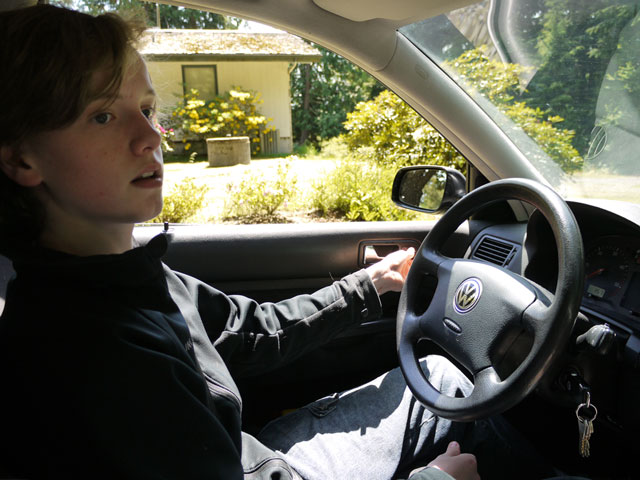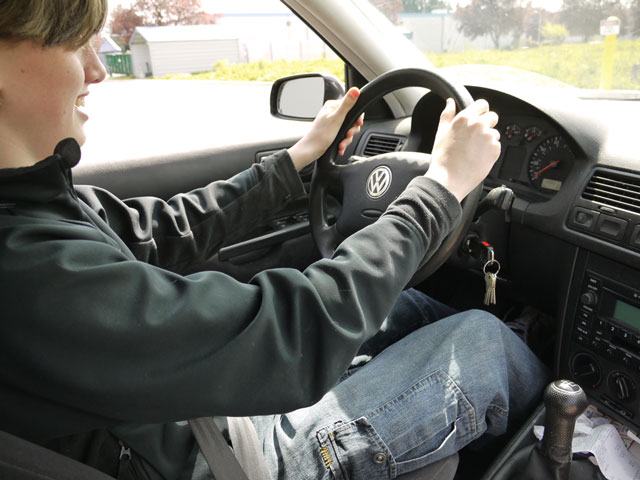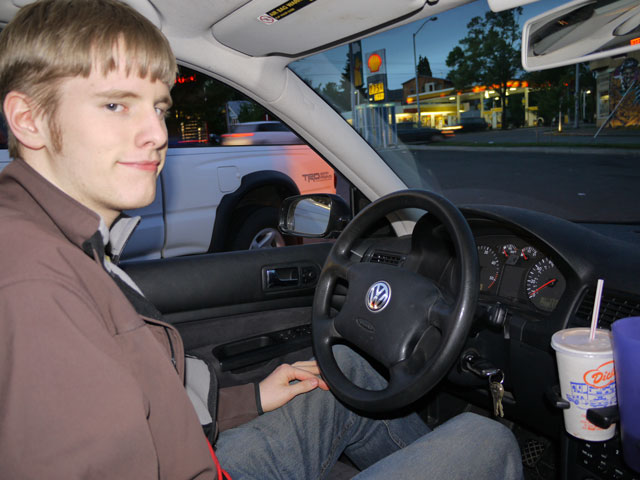
Seen in the paddock of the Northwest Historics, a disc brake equipped, B&S-powered wagon.
goolsbee.org, serving useless content from an undisclosed location since 1997

Seen in the paddock of the Northwest Historics, a disc brake equipped, B&S-powered wagon.

Yesterday’s Car Photo of the Day was a glimpse of an Alfa Romeo Montreal.
Perhaps it is my age, but I really think the Montreal is a beautiful car. Not is an objective sense, as in being a timeless design, but rather for its particular position in its particular time. It captures so well the early 70s Zeitgeist. Like an elegant Pierce-Arrow from the 1930s, a finned GM behemoth from the late 50s, or a VW Mk1 Golf GTI from the 80s, the Montreal just looks right for its time.

Powered by a small-displacement DOHC V-8, it had 200HP and was as fast as a contemporary Porsche 911. The Montreal was displayed as an unnamed concept car at Expo 67 in Montreal, Canada. Sold from 1970 through 1975, it was a significant stylistic departure for Alfa Romeo. Less than 4000 were built. Despite their rarity, and ‘halo car’ status when new, the market has not been kind to them, valuing them only slightly higher than their GTV contemporaries. Perhaps this is due to their lack of racing history compared to their Alfa brethren who were all actively campaigned on the track.

To me the car captures so much of what the early seventies was. It evokes the looks of the sports car racers of the day, from the GT-40 to the 917, while still being a car for the street. Bertone did an excellent job crafting the overall look. The Montreal is just one of those cars that I could not refuse. Not that I’ll ever go out looking for one, but I’d never turn one down if it appeared. Like any other era, the early 70s had its share of dreadfully awful and ugly cars, but this Alfa Romeo certainly sits in the rare category of Beautiful Cars of the Early 70s.

Pictured here is just a glimpse of a car, can you figure out its identity from a small glimpse?

Nicholas hit a major life milestone on Monday. Taking advantage of the holiday he started lessons on how to drive a manual transmission car.
Yep, he’s learning to use the Man Pedal!
He’s been driving for several months, and has completed driver’s education (what little there is of that in the USA!) He’s fairly competent on the road, in his mother’s slushbox-equipped machine, so the time is right for upping the difficulty level. I’ve been emphasizing “smoothness” to him while he’s driving Sue’s car, in the hope that he would appreciate its importance when he arrives here.
Lessons began in our driveway, with some discussion of the physics involved in how a clutch operates. I demonstrated the “smoothness” concept by closing the Jetta’s trunk on 6 standing beer bottles in front of our barn. Then driving the car up our steep driveway between the barn and the house, around the house and down the hill and around the corner into our garage… and opening the trunk to find the bottles all still standing. They clinked together a bit on the hill, but none actually fell over. 🙂 A few laps around the driveway with me at the wheel, explaining foot & hand actions while driving was followed by handing the car over to him and having him try. Launch from a stop is of course the hardest thing to do, and that was the entire focus of Lesson One on Monday afternoon. Having a Diesel to learn, with hundreds of foot-pounds of torque from idle on up certainly helps. Doing the start of the first lesson on the gravel driveway helped too. Nick got the hang of starting from a standstill OK… only killing the engine a few times. After he seemed to get the process down we went to the second half of the lesson: pavement.

We switched drivers and I piloted the car down into town and an industrial park near the airport with empty streets and parking lots with circuits around each building big enough for trucks with trailers. Putting Nick back behind the wheel, he started over with launch control, now with more traction under tires. It was a tad rough for a while, but started to get the hang of it. Two hours in he was very pleased with himself, even getting into 2nd gear now and then. To keep him humble I pulled one of the bottles out and stood it up on the passenger side floorboard and challenged him to start from a stop and not knock over the bottle. He was unable to do it, despite lots of effort. Mentally worn out he asked to end the lesson and head home.
I drove home, and Nick stood the bottle up. I was able to drive most of the way home, through 10+ miles of turns, lights, hills, and stop signs without knocking it over, though I wasn’t perfect. It did fall over 5 times, much to Nick’s joy. He was surprised how I could keep it standing most of the time however. As we approached some corners he’d say “Oh yeah, it’s gonna fall now!” only to be followed by a “How did you do that!?” 😉
The answer is simple: Thirty years of practice!
I can recall my Life Drawing professor in college having us do three one-hour drawings on the first day of class. He put them away for the entire semester and on the last days of class had us repeat the effort, then produced our earlier work for comparison. The differences were amazing. I’ll put the bottle away for a few months and spring it on Nick sometime before he takes his driver’s test at the end of his learning-permit year. Should be interesting for him to see his own improvement.

On Monday night I saw Christopher as well. He had spent the long weekend with his high school friend Rob Pieffle, who is attending the University of Washington. He made his way from Evergreen State in Olympia up to Seattle on public transportation, but was unable to accomplish the reverse trip the same way due to the commute-focused Tacoma-Seattle leg of the trip. I volunteered to provide the ride for him, though he had to drive to allow me some rest. I met him at the Wallingford location of Dick’s Drive-In. He took the wheel and drove us to his dorm at TESC in Olympia. As always it’s nice to see him. We chatted while he drove (very smoothly I might add!) down I-5. I’ll be heading down to collect him for the summer break sometime in the next 2 weeks.

This is not a Mopar engine. It is the same Ferrari 4-cam V-12 from yesterday’s bit of engine porn. As much as the Detroit Muscle Heads would like to think the “Hemi” was invented by Chrysler Corporation it just isn’t so. The hemispherical heads have existed almost as long as the internal combustion engine itself. Even my Jaguar, with its XK engine which originated just after WWII uses the design. Yeah, its gotta Hemi.

While we’re waiting for the intrepid carspotters to sort out the identity of yesterday’s “CPotD” here’s a car that creates no mystery: The Ubiquitous MG TD. This one was spotted at the All British Field Meet in Vancouver BC a few years back. I have no idea the origin or significance of the hood ornament, but it made this T-series car stand out from all the others. (Though to be honest, it looks cheap and plasticky on the car)
My father always loved MGs, and owned an MG A when he met my mom. So in some odd way I owe my very existence to Morris Garages in Abingdon-on-Thames, Berkshire (now Oxfordshire), UK. (So it is a slight irony I ended up living nearby when I moved to the UK in 1997!)
When I was a boy, my father had an MG B that he bought new, and drove every day to work. I don’t recall why he got rid of it, but not long after its departure the old MG fever hit him again and he found a tired old TD. I can still recall driving about an hour or so into Wisconsin from our home in northern Illinois to pick up the car. To my endless disappointment my older sister got to ride home with him and I was left to mope home with my mom in her ugly big blue early 70s Buick. That 1950 MG TD became our “ice cream” run, and “Sunday drive” car around the north Chicago suburbs and back roads. Dad eventually relented and agreed to carry the two of us, with either me or my sister sitting sideways in the TD’s odd little boot behind the seats. My memory is filled by the sound of the exhaust, the tick of the fuel pump, the octagonal motif throughout, the unique smell of the leather and woolen interior. The MG lasted a couple of summers, then the little engine threw a rod and required a complete rebuild. For the next year or so the TD became the subject of a restoration. The engine off at a mechanics shop, and the chassis dismantled and spread all around our suburban home; the garage, the basement, and occasionally to my mother’s chagrin, the family room. My father pored over Moss Motors and MG Mitten catalogs, and spewed all manner of new expletives into my young ears as he struggled with reassembly. While I am a passable mechanic when I put my mind to it, my father (bless his heart if he reads this) is basically a klutz. He did rise to the occasion though, and the car looked fantastic when he completed it; winning a “best in show” at a MG Club concours at it’s debut. The little red MG TD was a part of our family, moving with us to Texas, with MG Club gymkhanas, Sunday drives, and future fond memories. As we reached teenage driving age, it was used less and less though. My father’s job took more of his time and the car sat MG and more in the garage, under its “mitten”. It was shipped off to storage shortly after my parents caught my older sister out driving it around Houston in one of those “Risky Business” teenage moments. The MG TD vanished before I ever got my driver’s license, but it still left an impressive imprint on my mind, shaping a lot of my future.
I still smile whenever I see one.

More photos from that finest source of engine pR0n, RPM, the Markowski’s shop in Vermont. Pictured here are the cylinder heads of a Four Cam V-12 engine. Those readers who have turned a wrench in anger will likely have a suspicion why this engine is being rebuilt just by looking at it. Share your armchair diagnosis in the comments.